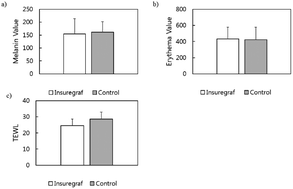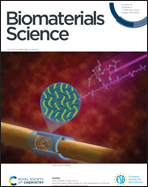A clinical trial with a novel collagen dermal substitute for wound healing in burn patients†
Abstract
Human skin incurs damage in various ways; a few of the recognizable factors are electric burns, chemical burns, scalding burns, surgery, and physical injuries, such as automobile accidents. If skin damage is extensive and severe enough [second degree and total body surface area (TBSA) involvement of >20%], the skin will lose the ability to regenerate itself. Burn wounds are treated in various ways. For full-thickness skin defects, the mainstay of treatment is an autologous split-thickness skin graft. However, there are some limitations due to scars, poor elasticity, and limitations in the joint movements due to contractures. Recently, artificial dermis has been widely used to minimize contractures. The use of dermal replacements for the treatment of burns brings new hope in maintaining the characteristics of the normal dermis. Herein, Insuregraf® was used for skin regeneration in patients who had burn injury from flames, electricity, heat, or steam. The mean take-rate values at 7 and 14 days after operation were 94.55 ± 3.02% and 97.40 ± 2.57%, respectively. Furthermore, areas covered by Insuregraf® showed higher mean values of trans-epidermal water loss (24.6 ± 3.9 g h−1 m−2), gross elasticity (Ua/Uf = 0.76 ± 0.24), and biological elasticity (Ur/Uf = 0.55 ± 0.1). These values were much better than those of the control where Insuregraf® was not used (p = 0.030, p = 0.040, and p = 0.013, respectively). Furthermore, the biomechanical scar properties of Insuregraf® and Matriderm were very similar. Hence, we suggest that Insuregraf® can be used in the medical field.



 Please wait while we load your content...
Please wait while we load your content...